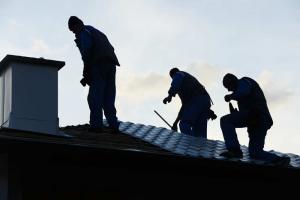Preventive Maintenance Pays Off: Annual Roof Inspection Checklist for Commercial Properties
Thad Brown, owner and founder of Dynamic Alliance Roofing LLC in Wisconsin Rapids, Wisconsin, recommends that every commercial property manager follow a structured inspection checklist at least once a year to catch small issues before they become costly problems. With over four decades in the commercial roofing industry, Brown emphasizes the importance of early detection and consistency.
“An annual inspection isn’t just about looking for damage—it’s about extending the life of the roof and ensuring the rest of the building doesn’t suffer due to preventable failures,” said Brown. “Water is one of the most destructive elements to a commercial building. It finds the smallest opening and exploits it. Regular inspections stop that before it starts.”
The recommended inspection checklist includes the following core elements:
1. Inspect Flashing and Edge Details
Flashing around HVAC units, skylights, vents, and perimeter edges is a common entry point for water. Cracked or loose flashing should be repaired or replaced immediately. Special attention should be paid to metal terminations and sealants that degrade with age.
2. Check Roof Membrane for Blisters, Cracks, or Punctures
Roofing membranes—whether TPO, EPDM, or built-up—often show wear in the form of blisters or cracks. Sharp debris, foot traffic, or UV exposure can cause punctures or degradation. Areas around rooftop traffic paths should be reviewed for reinforcement or repair.
3. Clean and Clear Drainage Systems
Roof drains, scuppers, and downspouts must be unobstructed. Debris buildup can lead to ponding water, which accelerates membrane breakdown and adds unnecessary load weight to the structure. Inspect strainers and confirm downspout functionality to ensure proper flow.
4. Evaluate Roof Penetrations
Penetrations such as pipes, conduits, and mechanical supports are high-risk points for leaks. Ensure that boots, collars, and sealants are intact and that any movement has not compromised the integrity of the waterproofing.
5. Inspect Seams and Transitions
Seams in membrane roofs, especially those that are glued or heat-welded, require close attention. Any lifting, peeling, or separation is a red flag and should be addressed immediately to prevent water intrusion beneath the membrane.
6. Examine Parapet Walls and Copings
The transition between walls and roofing material often gets overlooked. Check parapet caps, wall coatings, and junction points for signs of deterioration or cracks that could lead to leaks and structural damage.
7. Assess Interior Ceiling for Water Stains or Mold
Sometimes the first signs of a roofing issue appear indoors. Review ceiling tiles, interior walls, and attic spaces for water staining, mold growth, or musty odors—indicators of possible roof leaks.
8. Document and Photograph All Findings
Detailed documentation with photographs helps build a history of roof performance and identifies recurring trouble spots. This becomes essential for warranty claims and for guiding future maintenance priorities.
9. Review Rooftop Equipment Mountings
Any equipment mounted to the roof should be inspected for rust, loose fasteners, and degraded base attachments. Improperly mounted units can compromise membrane integrity and invite moisture.
10. Verify Perimeter Security and Wind Uplift Areas
Edges and corners are vulnerable to wind uplift. Inspect for loose fascia, detached metal edge components, or billowing membrane. These conditions pose safety risks and often lead to rapid roof failure if left unaddressed.
Brown also suggests pairing annual inspections with seasonal spot checks—especially after hailstorms, snow accumulation, or high winds. “Extreme weather is part of the reality here in Wisconsin. A spring and fall spot-check, combined with a detailed annual inspection, is the best way to protect a long-term roofing investment,” Brown added.
According to building envelope professionals, the cost of regular inspections is significantly lower than the expense of emergency leak response or premature roof replacement. Insurance claims due to roof neglect are also more likely to be denied, further reinforcing the value of routine maintenance.
The team at Dynamic Alliance Roofing has worked with commercial clients ranging from office parks and schools to warehouses and municipal buildings. Brown notes that establishing a preventive maintenance agreement can help standardize these inspections and keep properties compliant with industry best practices.
Property managers are also encouraged to keep inspection records organized in case of audits, warranty verifications, or safety compliance reviews. A well-documented maintenance history often supports higher property valuations during sale or refinancing.
For property owners who haven’t had a recent roof inspection, the next change in seasons could bring unwelcome surprises. A comprehensive checklist is the simplest way to keep facilities dry, functional, and safe—without relying on a crisis to trigger action.
Morgan Thomas
Rhino Digital, LLC
+1 504-875-5036
email us here
Visit us on social media:
Facebook
Legal Disclaimer:
EIN Presswire provides this news content "as is" without warranty of any kind. We do not accept any responsibility or liability for the accuracy, content, images, videos, licenses, completeness, legality, or reliability of the information contained in this article. If you have any complaints or copyright issues related to this article, kindly contact the author above.
CommitCon 2026 Launches in DFW to Challenge the Status Quo of Business Conferences
Gerard Endenburg - Pionier der Soziokratie verstorben
SolarisTech Launches Global BWM Training Series Ahead of 2025 Paris and Tokyo MoU PSC CIC
Więcej ważnych informacji
 Jedynka Newserii
Jedynka Newserii

 Jedynka Newserii
Jedynka Newserii

Konsument

Tylko 35 proc. Celów Zrównoważonego Rozwoju ONZ możliwe do osiągnięcia przed 2030 r. Potrzebna ściślejsza współpraca międzynarodowa
Jak wynika z raportu ONZ, choć w ciągu ostatniej dekady dzięki dążeniu do realizacji przyjętych celów udało się poprawić życie milionów ludzi na całym świecie, to jednak tempo zmian pozostaje zbyt wolne, by dało się je osiągnąć do 2030 roku. Postęp hamują przede wszystkim eskalacja konfliktów, zmiana klimatu, rosnące nierówności i niewystarczające finansowanie. Jak wynika ze sprawozdania Parlamentu Europejskiego, problemem jest także brak ścisłej współpracy międzynarodowej i sceptyczne podejście niektórych państw ONZ.
Przemysł spożywczy
UNICEF: Wszystkie dzieci poniżej piątego roku życia w Gazie cierpią z powodu niedożywienia. Sytuacja jest katastrofalna

Ataki Izraela na Strefę Gazy i jej izolacja doprowadziły do całkowitego załamania podstawowych usług i ograniczenia możliwości dostaw i dystrybucji pomocy humanitarnej – wskazuje UNICEF. W efekcie setki tysięcy Palestyńczyków są w sytuacji ciągłego zagrożenia życia i cierpią z powodu niedożywienia i głodu. Ta klęska dotyczy praktycznie wszystkich dzieci poniżej piątego roku życia. Konflikty są jednym z głównych przyczyn braku bezpieczeństwa żywnościowego, głodu i niedożywienia na świecie. Szczególnie dotyczy to Afryki i Azji Zachodniej.
Prawo
Branża ciepłownictwa czeka na unijną i krajową strategię transformacji. Liczy na większe fundusze i korzystne regulacje

Komisja Europejska zapowiedziała rozpoczęcie w I kwartale 2026 roku prac nad strategią dla ciepłownictwa i chłodnictwa. Nad tym strategicznym dokumentem w zakresie ciepłownictwa pracuje także polski rząd. Branża podkreśla, że obie te strategie będą miały kluczowe znaczenie dla trwającej transformacji w ciepłownictwie, czyli przyszłości ogromnych inwestycji, które czekają sektor do 2050 roku. Jednocześnie apeluje o większe wsparcie tego procesu ze środków publicznych.
Partner serwisu
Szkolenia

Akademia Newserii
Akademia Newserii to projekt, w ramach którego najlepsi polscy dziennikarze biznesowi, giełdowi oraz lifestylowi, a także szkoleniowcy z wieloletnim doświadczeniem dzielą się swoją wiedzą nt. pracy z mediami.



![Nestlé w Polsce podsumowuje wpływ na krajową gospodarkę. Firma wygenerowała 0,6 proc. polskiego PKB [DEPESZA]](https://www.newseria.pl/files/1097841585/fabryka-nesquik_1,w_85,r_png,_small.png)






.gif)

 |
| |
| |
|